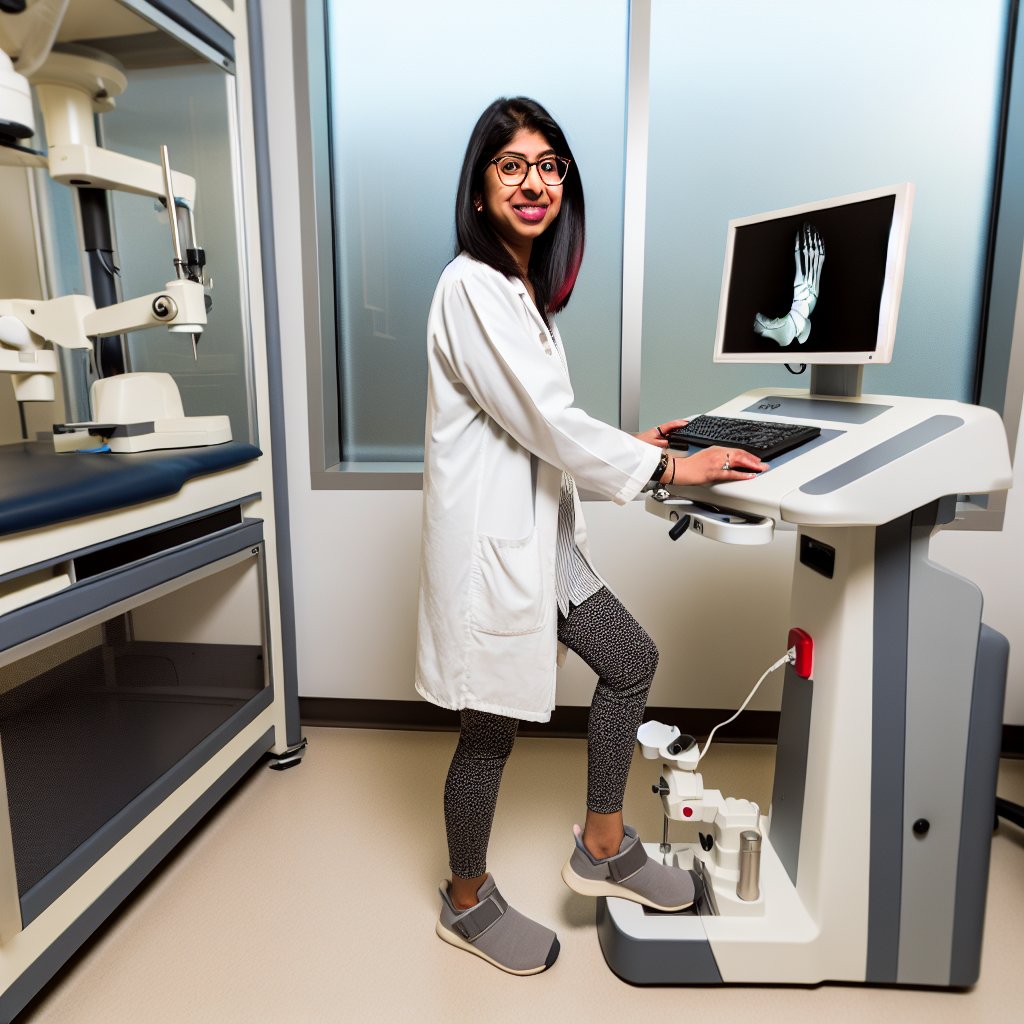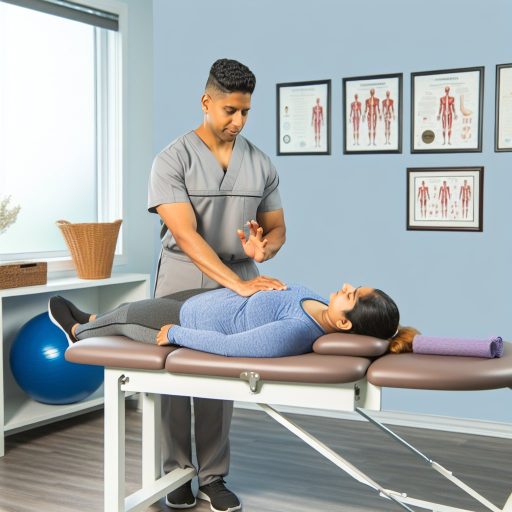Introduction to Advanced Technologies in Podiatry
Modern podiatrists utilize advanced technologies to enhance patient care.
These innovations improve diagnostic accuracy and treatment efficacy.
Additionally, they streamline clinic operations for better patient experiences.
Understanding these technologies helps patients appreciate their significance.
Innovative Diagnostic Tools
Diagnostic imaging plays a crucial role in podiatric assessments.
X-rays provide clear views of bone structures and alignments.
Magnetic resonance imaging (MRI) reveals detailed soft tissue conditions.
Ultrasound allows for real-time visualization of foot and ankle structures.
Additionally, gait analysis systems assess walking patterns for abnormalities.
Advanced Treatment Techniques
Laser therapy is gaining popularity for various foot conditions.
This technique reduces pain and promotes healing effectively.
Furthermore, shockwave therapy stimulates healing in chronic injuries.
Custom orthotics are now produced using 3D printing technology.
This ensures a precise fit for individual patient needs.
Telehealth and Remote Monitoring
Telehealth has transformed how podiatrists communicate with patients.
Patients can receive consultations without needing to travel.
This approach increases accessibility, especially for those in remote areas.
Remote monitoring devices track treatment progress over time.
These tools contribute to more personalized care plans for patients.
Educational Technologies
Advanced technologies also enhance education for podiatry students.
Virtual reality (VR) simulations provide realistic training experiences.
Interactive online platforms facilitate engaging learning opportunities.
Furthermore, mobile applications support continuous education and skill development.
These advancements ensure that podiatrists stay informed about best practices.
3D Imaging and Printing for Custom Orthotics
The Role of 3D Imaging
3D imaging revolutionizes how podiatrists analyze foot structure.
Unlock Your Career Potential
Visualize a clear path to success with our tailored Career Consulting service. Personalized insights in just 1-3 days.
Get StartedIt captures precise measurements using advanced scanning technology.
This technology enhances diagnostic accuracy significantly.
Furthermore, it provides detailed visual models of patients’ feet.
Doctors can study these models to identify potential issues.
Benefits of Custom Orthotics
Custom orthotics offer personalized solutions for foot problems.
They improve comfort and alignment for patients with various conditions.
Additionally, these devices can alleviate pain during daily activities.
Ultimately, they enhance overall foot health and mobility.
3D Printing Technology
3D printing allows for the creation of custom-fit orthotics quickly.
This process uses lightweight, durable materials for better performance.
Moreover, it reduces the time between diagnosis and treatment.
Podiatrists can produce orthotics in-house, streamlining patient care.
Case Studies and Applications
Many clinics report successful outcomes using 3D technologies.
For instance, Dr. Emily Carter in Seattle uses 3D printing daily.
Her patients appreciate the quick turnaround on their orthotics.
Another successful case is from the Advanced Foot Care Institute.
They have reduced fabrication costs while improving patient satisfaction.
Future Developments in the Field
The future holds even more advancements for podiatry.
As technology improves, so will the precision of orthotic solutions.
Future innovations may include smart orthotics with embedded sensors.
These sensors could monitor foot health in real-time.
Ultimately, these advancements will enhance patient care significantly.
Laser Therapy: Benefits and Applications in Foot Care
Overview of Laser Therapy in Podiatry
Laser therapy has transformed modern podiatric treatments.
This technology effectively addresses various foot ailments.
It utilizes focused light to stimulate healing and repair tissue.
Furthermore, it provides a non-invasive alternative to traditional methods.
Benefits of Laser Therapy
One major benefit is pain relief for patients.
This therapy alleviates discomfort associated with foot conditions.
Additionally, it reduces inflammation significantly.
This minimizes the need for pain medication.
Moreover, laser therapy accelerates the healing process.
Patients often experience quicker recovery times.
Applications of Laser Therapy
Laser therapy is applicable for various foot conditions.
Common uses include treating plantar fasciitis and tendonitis.
It also addresses diabetic ulcers and nail fungus.
Effective treatment for sports injuries is another application.
Moreover, laser therapy enhances post-surgical recovery.
Safety and Considerations
Safety is a priority in laser therapy procedures.
Practitioners use specific protocols to ensure patient comfort.
Most patients report minimal side effects.
However, some may experience temporary redness.
It is essential to discuss any concerns with your podiatrist.
Learn More: Dental Specialties: Exploring Career Options in Canada
Telemedicine: Remote Consultations and Treatment Monitoring
Introduction to Telemedicine in Podiatry
Telemedicine has revolutionized the way podiatrists deliver care.
This technology allows for remote consultations and ongoing treatment monitoring.
Patients can connect with specialists without leaving their homes.
Benefits of Remote Consultations
Remote consultations provide convenience for patients and doctors.
They eliminate travel time, making appointments more accessible.
Additionally, these consultations reduce the risk of infections.
Technological Tools Used
Modern podiatrists utilize various tools for telemedicine.
Video conferencing platforms enable face-to-face consultations.
Digital monitoring devices track patients’ progress in real time.
Examples of Successful Telemedicine Implementation
Dr. Sarah Mitchell successfully uses telemedicine for diabetic foot care.
She monitors her patients’ conditions through video calls.
As a result, her patients report higher satisfaction and improved outcomes.
Considerations for Patients
Patients should have a reliable internet connection for telemedicine visits.
They must also ensure their devices have working cameras and microphones.
Moreover, privacy should be a top priority during consultations.
Future of Telemedicine in Podiatry
The future of telemedicine in podiatry looks promising.
Advancements in technology will enhance remote care even further.
Podiatrists will likely adopt more sophisticated tools for monitoring.
Gain More Insights: Kinesiologists’ Role in Enhancing Athletic Performance
Biomechanical Analysis: Gait Analysis and Motion Capture
Importance of Biomechanical Analysis
Biomechanical analysis plays a crucial role in podiatry.
It helps professionals understand how the body moves.
Moreover, it aids in identifying potential issues before they become serious.
Gait Analysis: Understanding Movement
Gait analysis assesses the walking patterns of patients.
This technique focuses on various parameters of movement.
For instance, it evaluates stride length and width.
Additionally, it considers speed and rhythm during walking.
By observing these elements, podiatrists can identify abnormalities.
Tools Used in Gait Analysis
Gait analysis utilizes several advanced tools.
Motion capture systems provide detailed insights into movement.
Pressure sensors can measure foot pressure distribution.
Video analysis enhances the evaluation by providing visual data.
Together, these technologies create a comprehensive view of a patient’s gait.
Motion Capture Technology
Motion capture technology tracks body movements in real time.
This method uses reflective markers placed on key body parts.
High-definition cameras capture the data as the patient walks or runs.
Additionally, specialized software processes this data for analysis.
Benefits of Motion Capture
Motion capture technology offers numerous advantages.
It delivers precise measurements of movement dynamics.
Furthermore, it assists in creating tailored treatment plans for patients.
Patients can visually comprehend their gait issues through this analysis.
Application in Clinical Practice
Podiatrists integrate gait analysis and motion capture into their practices.
This integration enhances patient diagnosis and treatment quality.
Consequently, it leads to improved patient outcomes and satisfaction.
Moreover, it empowers podiatrists to implement evidence-based practices.
Discover More: How Chiropractors Treat Common Sports Injuries
Digital Foot Scanning: Enhancements in Diagnosis Accuracy
Overview of Digital Foot Scanning
Digital foot scanning represents a breakthrough in podiatric diagnostics.
This technology captures precise images of a patient’s feet.
Advanced software analyzes the scans for optimal outcomes.
As a result, podiatrists can diagnose conditions more accurately.
Benefits of Enhanced Diagnosis
Improved diagnostic accuracy leads to effective treatment plans.
Digital foot scanning helps identify issues like flat feet or high arches.
Additionally, it assists in detecting deformities and other abnormalities.
Integration with Treatment Solutions
Once diagnosis is completed, treatment options can be tailored.
Podiatrists can utilize data for creating custom orthotics.
Furthermore, the technology supports effective monitoring of patient progress.
Patient Experience Considerations
Digital foot scanning offers a non-invasive alternative to traditional methods.
Patients experience minimal discomfort during the scanning process.
Moreover, reduced time spent on foot evaluation enhances patient satisfaction.
Future Innovations in the Field
As technology advances, digital foot scanning will continue to evolve.
Expect further enhancements in imaging techniques and analysis software.
Ultimately, these innovations will lead to improved podiatric health outcomes.
Find Out More: Benefits Of Chiropractic Care For Overall Wellbeing

Wearable Technology: Tracking Patient Progress and Recovery
Introduction to Wearable Technology
Wearable technology revolutionizes healthcare, especially in podiatry.
These devices help monitor patients’ foot health effectively.
Moreover, they provide valuable data for podiatrists.
Types of Wearable Devices
Several types of wearable devices are available for podiatric use.
- Smart socks track foot temperature and pressure.
- Fitness trackers monitor overall activity levels.
- Smart insoles assess gait and foot mechanics.
Benefits of Wearable Technology
Wearable technology offers numerous benefits to patients.
Firstly, it enables real-time data collection for better accuracy.
Secondly, patients engage more actively in their recovery.
Additionally, these devices enhance communication between doctors and patients.
Tracking Progress and Recovery
Wearable devices allow for continuous monitoring of patients.
They provide insights into the healing process post-surgery.
This data can help podiatrists make informed decisions.
Consequently, personalized treatment plans can be adapted quickly.
Challenges and Considerations
Despite their advantages, challenges exist with wearable technology.
For instance, some patients may find devices uncomfortable.
Moreover, issues with data privacy and security are important.
It is essential to address these concerns to ensure wider adoption.
Future of Wearable Technology in Podiatry
The future of wearable technology looks promising in podiatry.
Advancements will likely improve device functionality and comfort.
Furthermore, integration with telehealth services is on the horizon.
This integration will enhance patient care and accessibility.
Artificial Intelligence in Podiatry: Diagnosis and Treatment Planning
The Role of Artificial Intelligence
Artificial intelligence plays a crucial role in modern podiatry.
It enhances accuracy in diagnosing foot and ankle conditions.
Additionally, AI streamlines the treatment planning process.
AI-Powered Diagnostic Tools
Podiatrists utilize AI-powered diagnostic tools extensively.
These tools analyze medical images for signs of disease.
They detect subtle abnormalities that may escape human observation.
For instance, a recent study showed a 95% accuracy in detecting diabetic foot ulcers.
Benefits of AI in Treatment Planning
AI assists in creating personalized treatment plans for patients.
It considers various factors such as medical history and lifestyle.
This tailored approach improves patient outcomes significantly.
Moreover, AI can suggest alternative therapies based on the latest research.
Case Studies Showcasing Success
Several case studies highlight the effectiveness of AI in podiatry.
One example involves a clinic reducing healing time for foot injuries.
Another study reported fewer complications using AI-guided treatment plans.
Challenges and Limitations
Despite its benefits, AI faces certain challenges in podiatry.
Data privacy concerns remain a significant issue.
Moreover, cost barriers can limit access to advanced AI technologies.
Furthermore, training practitioners to use AI effectively proves challenging.
Future Trends in AI and Podiatry
The future of AI in podiatry looks promising.
Emerging technologies continue to evolve, offering new solutions.
Integration of AI with wearable devices will enhance real-time monitoring.
This integration may lead to quicker interventions and improved care.
Future Trends: Emerging Technologies Shaping Podiatry
Telemedicine Advancements
Telemedicine revolutionizes how podiatrists reach their patients.
It allows real-time consultations from the comfort of home.
Patients benefit from immediate advice on foot health issues.
This technology bridges geographical gaps in healthcare access.
3D Printing in Podiatry
3D printing creates customized orthotics and prosthetics quickly.
This technology enhances patient comfort and satisfaction.
Additionally, it reduces costs compared to traditional methods.
Podiatrists can now provide tailored solutions effectively.
Artificial Intelligence in Diagnostics
Artificial Intelligence (AI) aids in diagnosing foot and ankle conditions.
AI algorithms analyze medical images for accurate assessments.
This technology enhances clinical decision-making processes.
Consequently, it improves patient outcomes through timely interventions.
Wearable Technology for Monitoring
Wearable devices track foot health and activity levels.
These gadgets provide valuable data for patient management.
They help podiatrists monitor recovery post-surgery effectively.
Moreover, they encourage patients to maintain active lifestyles.
Bioprinting for Regeneration
Bioprinting offers exciting possibilities for foot tissue regeneration.
This developing technology may one day replace damaged tissues.
Podiatrists could utilize bioprinting for surgical repairs.
Research continues into its feasibility and safety in practice.
Additional Resources
Interventions for increasing the use of shared decision making by …
New Evidence-Based Therapies for Complex Diabetic Foot Wounds …




